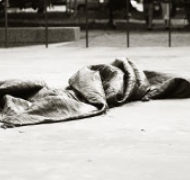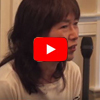Art in the Time of Holocaust
Blog / Produced by The High Calling
As I enter the building, darkness hems me in. The concrete, triangular building entraps me and allows only a sliver of light through its peaked top. I weave through the downward-sloping tunnel, with each turn glimpsing light at the end.
This is Yad Vashem, the Holocaust Martyrs’ and Heroes’ Remembrance Authority in Israel. And though walking the hard floors through the winding tunnels makes my feet and heart ache, Yad Vashem isn’t a place of hatred. It offers hope and the noblest of humanity in the dankest of circumstances.
Photos and stories of the Holocaust lace the tunnels of the museum like barbed wire. Between these hang the art of the suffering.
In concentration camps, ghettos, and hiding places, Jewish artists sketched, drew, and painted during the Holocaust. Their works had been concealed, and many artists died for creating them. The artists depict the atrocities and suffering of the time, but also the moments of hope and beauty – a Jewish wedding, an old man nursing a woman at her bedside, or two children peering at distant mountains. This art testifies to humans’ drive to create even when fighting for survival, to the need to work through suffering, evil, and the human condition through art.
Recently, a fellow artist confessed that he was considering giving up art. What did it mean compared to the work of social justice? He couldn’t justify spending time on his poetry when he could be feeding the hungry and clothing the poor. His struggle questioned the purpose of art when it does not directly contribute to the areas of justice and love.
Some may answer his question (and indeed I did) by suggesting he write poetry that reflect his concerns. Art has a historical connection to these topics. Or, like People Not Profit, he could sell his art to fund development projects.
But to limit art to only these functions subjugates it to utility. The art of the Holocaust did not give food to those starving on unrealistic rations. It did not save any from the gas chambers. It did not provide warm clothing for those in threadbare uniforms. Still, Jews and other martyrs created because the act of creating is essential to what it means to be human. When stripped of their homes and possessions, when separated from family and community, when their stomachs echoed their emptiness, they held pencil and paintbrush and expressed their horrors and hope. They testified to the atrocities and searched for beauty.
Art is more than pragmatics. Not only did the Jews create with no hope of receiving anything in return or accomplishing freedom (like their friends who formed resistance militias in the ghettos), but they risked their lives for their art. They found a power in art separate from functional services.
In a time of world-wide hunger, war, and economic recession, art falls to the side because of what it can’t accomplish. It also emerges as a tool for escape. We want to see a different world, one where everyone has their happily-ever-after exactly how they ordered it, where light shines benevolently on nostalgic scenes of our imagined past. Don’t we deserve at least this? But the Jewish artists of the Holocaust refused to indulge in this type of diversion. They portrayed the world as they saw it. Far from running from evil in their art, they unearthed the full extent of the corruption of mankind. They gave us the faces of those who inflict and of those who fell. They find beauty in the midst of the evil – not apart from it, but by working through it and finding hope at the other end. In doing so, they triumph over evil rather than pretending it doesn’t exist. It is beauty through brokenness.
The art found in Yad Vashem reveals that art has the power to explore pain, healing, and tender hope. It tells the stories of individuals who hurt, loved, died, fought, and hoped, and it invites us to enter into their stories and lives. It reminds us so that we, too, may fight evil and search out beauty and goodness in our lives and in our art.
As I come to the end of Yad Vashem’s museum, I step onto an outside patio. The walls bend outward, releasing their triangular enclosure and opening up into a view of the mountains. The light, now freed, warms me. I’m reminded of Samuel Bak’s painting: two children hold hands as they gaze at the distant mountains. Both the painting and this architecture signal hope, beauty, and goodness. I cross over a bridge, sturdy, meant to express that Hitler’s best efforts served to strengthen the Jewish people rather than annihilate them. This, in essence, is the same picture given in the art: the full gamut of the human spirit – creative, corrupt, beautiful, courageous, falling, fallen, and redeemed.
This article is a reprint, courtesy of Curator Magazine. Curator Magazine, a publication of the International Arts Movement, announces the signs of a “world that ought to be” as we find it in our midst, and seeks to inspire people to engage deeply with culture that enriches life and broadens experience.
Image by Kelly Sauer. Used with permission. Post by Heather Goodman.





